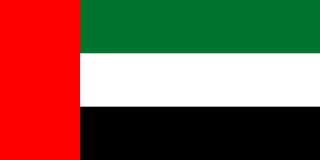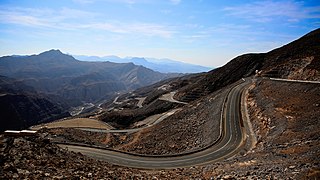
The United Arab Emirates is a country in the eastern part of the Arabian Peninsula located on the southeastern coast of the Persian Gulf and the northwestern coast of the Gulf of Oman. The UAE consists of seven emirates and was founded on 2 December 1971 as a federation, after UK armed forces left the region. Six of the seven emirates declared their union on 2 December 1971. The seventh, Ras al Khaimah, joined the federation on 10 February 1972. The seven sheikdoms were formerly known as the Trucial States, in reference to the truce treaties established with the British in the 19th century.

The United Arab Emirates is a high-income developing market economy. The UAE's economy is the 4th largest in the Middle East, with a gross domestic product (GDP) of US$415 billion in 2021-2023.

The United Arab Emirates (UAE), or simply the Emirates, is a country in West Asia, in the Middle East, at the eastern end of the Arabian Peninsula. It is a federal, elective monarchy composed of seven emirates, with Abu Dhabi as its capital. It shares land borders with Oman to the east and northeast, and with Saudi Arabia to the southwest; as well as maritime borders in the Persian Gulf with Qatar and Iran, and with Oman in the Gulf of Oman. As of 2024, the UAE has an estimated population of over 10 million, of which 11% are Emiratis; Dubai is the most populous city and is an international hub. Islam is the official religion and Arabic is the official language, while English is the most spoken language and the language of business.

Dubai is the most populous city in the United Arab Emirates and the capital of the Emirate of Dubai, the most populated of the country's seven emirates. The city has a population of around 3.79 million, more than 90% of which are expatriates.

The Emirate of Fujairah is one of the seven emirates that make up the United Arab Emirates, the only one of the seven with a coastline solely on the Gulf of Oman and none on the Persian Gulf. Its capital is Fujairah.

The Emirate of Umm Al Quwain is one of the seven constituent emirates of the United Arab Emirates, located in the north of the country. It is the second smallest and least populous emirate in the UAE and borders the Persian Gulf. Umm Al Quwain lies between Ras Al Khaimah and Sharjah/Ajman on the west coast. It has a coastline stretching to 24 km. It had 72,000 inhabitants in 2007 and has an area of 770 km2 (300 sq mi).
The history of the Jews in the United Arab Emirates describes the historical and modern presence of Jews over the millennia in the Middle East and the recorded meetings with Jewish communities in areas that are today in the geographic territories of the United Arab Emirates.

Sharjah is the third-most populous city in the United Arab Emirates, after Dubai and Abu Dhabi. It is the capital of the Emirate of Sharjah and forms part of the Dubai-Sharjah-Ajman metropolitan area.

Human rights in Dubai are based on the Constitution and enacted law, which promise equitable treatment of all people, regardless of race, nationality or social status, per Article 25 of the Constitution of the United Arab Emirates. Despite this, Freedom House has stated: "Extreme forms of self-censorship are widely practiced, particularly regarding issues such as local politics, culture, religion, or any other subject the government deems politically or culturally sensitive. The Dubai Media Free Zone (DMFZ), an area in which foreign media outlets produce print and broadcast material intended for foreign audiences, is the only arena where the press operates with relative freedom."
According to Human Rights Watch, there is substantial discrimination against women in the United Arab Emirates. The status of women has improved over the years. UAE performs better on metrics of gender equality than many other states in the Gulf region, and it has been making reforms to protect women's rights and empower women in different sectors. Critics describe some of these reforms as window dressing.
The Constitution of the United Arab Emirates provides for freedom of religion by established customs, and the government generally respects this right in practice; however, there are some restrictions. The federal Constitution declares that Islam is the official religion of the country. The Government confirmed it illegal to convert from Islam and leaving the Islamic faith is considered apostasy, a crime punishable by death.
Indians in the United Arab Emirates constitute the largest part of the population of the country. Over 3,860,000 Indian expats are estimated to be living in the United Arab Emirates, with over 38% of the country's total population and the fourth highest number of overseas Indians in the world, after the United States, Saudi Arabia, and Malaysia. Indian contact with the emirates that now constitute the UAE dates back several centuries, as a result of trade and commerce between the emirates and India. The UAE has experienced a tremendous increase in the population of resident Indians who initially migrated to the country as a result of opportunities in petroleum. Now, Indians are key to the UAE's construction, retail, financial services, healthcare, manufacturing and transport sectors. A sizeable minority of Indian migrants are involved in professional services and entrepreneurship. Relations between India and the UAE have traditionally been very friendly.

Christians in the United Arab Emirates account for 12.9% of the total population according to 2020 estimates.

The culture of the United Arab Emirates is part of the culture of Eastern Arabia. Its historical population was a small tribal community that changed with the arrival of an influx of foreign nationals in the mid-20th century. Emirati culture is a blend of Arabian, Islamic, and Persian cultures, with influences from the cultures of East Africa and Indian Subcontinent. Islam has had a prominent influence on local architecture, music, attire, cuisine, and lifestyle.
Islam is the majority and official religion in the United Arab Emirates, professed by 74.5% of the population as of 2020. 63.3% are Sunni, 6.7% are Shia, while 4.4% follow another branch of Islam. The Al Nahyan and Al Maktoum ruling families adhere to the Maliki school of jurisprudence. Many followers of the Hanbali school are found in Sharjah, Umm al-Quwain, Ras al-Khaimah and Ajman. Their followers include the Al Qasimi ruling family. The other main religions present in the country include Christianity (12.9%), Hinduism (6.2%), and Buddhism (3.2%). Zoroastrians, Druze, Baha'i, Judaism, and Sikhism are also practiced by some non-nationals. 1.3% of the population is agnostic.
Expatriates in the United Arab Emirates represent about 88% of the population, while Emiratis constitute roughly 12% of the total population, making the UAE home to one of the world's highest percentage of expatriates.

Shia Islam is practiced by a minority of Muslims in the United Arab Emirates. It is also practiced among expatriate Muslim communities living in the country, most notably Iranians, as well as some Arabs, Pakistanis, Indians, and other nationalities. Non-Twelver Shia branches such as Ismailis and the Dawoodi Bohras are also present in the UAE and account for less than 5% of the total population. Shia nationals are concentrated in the city of Dubai, belonging mostly to the latest (1920s) wave of migrants who managed to obtain citizenship.

Tourism in the United Arab Emirates is an important part of the Emirati economy. In 2023, the tourism sector employed 809,300 people and contributed 220 billion dirham to the national gross domestic product (GDP), accounting for 12% of it. In 2024, the UAE was the 6th destination globally by international tourism receipts according to the World Tourism rankings, and it ranked 18th globally in the Travel and Tourism Development Index.
Sharjah is the third largest and third most populous city in the United Arab Emirates (UAE). Along with Dubai it hosts numerous major tourist events and is home to significant and acknowledged museums on historical heritage, Islamic architecture. Apart from it Sharjah is known for traditional Arabian markets. The city is part of the Dubai-Sharjah-Ajman metropolitan area and is located along the southern coast of the Persian Gulf.











